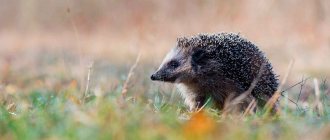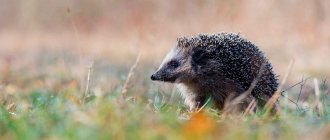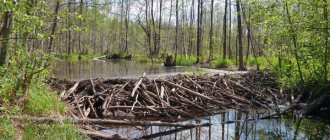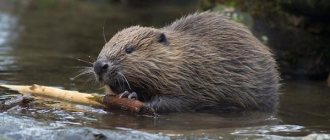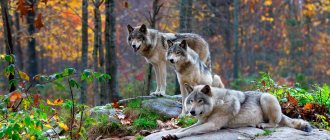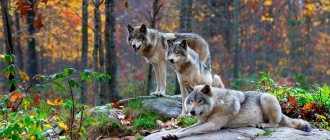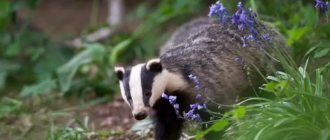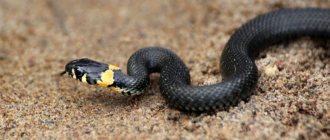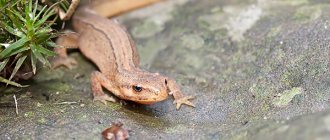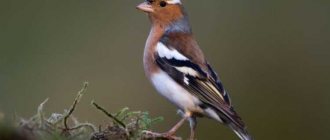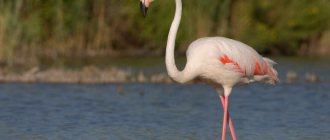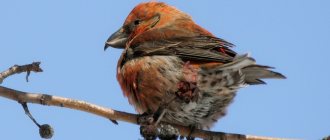- Wild animals
- >>
- Mammals
Among all the rodents that live on our planet, the largest in the Old World is the river beaver . It usually lives in both rivers and lakes. You can find many enthusiastic descriptions and reviews about this animal, as it amazes people with its hard work. It personifies order, is often found in fairy tales, and acts there as a positive hero. But what is a river beaver, where does it live and what types are there?
Origin of the species and description
Photo: River beaver
Unfortunately, most people know about this animal only by hearsay. Not everyone can even pronounce its name correctly. For example, the word "beaver" is confused with "beaver". Meanwhile, the second word denotes the name of the fur of this animal. Although in spoken language no one adheres to these rules anymore.
Video: River beaver
The beaver family is known on different continents. There are 22 genera known, and for the first time this species of animal appears in Asia. Some varieties were very large. To this day, fossilized remains have been preserved, which scientists date to the Eocene.
The most famous beaver, the species of which disappeared a long time ago, is a giant that existed during the Pleistocene. Science knows about two of its varieties - the Siberian Trogontherium cuvieri, and the North American Castoroides ohioensis.
If the calculations were carried out correctly, then, according to the fossil skull, the height of the animal reached 2.75 m, and its total mass was 350-360 kg. That is, it was similar in size to a brown bear. The modern species of beaver used to live in Europe and Asia, almost everywhere in the forest-meadow zone. But by the beginning of the 20th century, this animal was practically exterminated in most of the planet because of its valuable fur.
Area
Eurasian beavers once densely inhabited all of Europe and Asia. However, excessive killing of animals for fur and beaver dross, as well as habitat loss, have significantly reduced the population, almost to the point of extinction. In the 19th century, there were no beavers left in most countries of Europe and Asia. In the 20th century, there were approximately 1,300 beavers in the wild. Control and reproduction efforts have led to an increase in the European beaver population. Currently, beavers live in France, Germany, Poland, southern Scandinavia and central Russia. However, their populations are small and scattered throughout these areas.
Appearance and features
Photo: Animal river beaver
Today, only 2 surviving species of beaver can be found in nature. We are talking about the common beaver, which can be found in Eurasia, as well as the Canadian species that lives in North America. In terms of their appearance, no differences were found between them. And their habits are very similar, they have the same sizes.
But, as recent studies have shown, differences between them are observed at the genetic level. The European beaver has 48 chromosomes, while its relative from the American continent has only 40. This means that these two species cannot be crossed to create a new variety.
Several features of the beaver can be identified regarding its appearance and general physical image:
- if you do not take into account the length of the tail, the animal can grow up to 1 meter in length;
- tail length can be from 0.4 to 0.5 m;
- if it is a young beaver, its weight is usually 30-32 kg;
- an old male can gain weight up to 45 kg;
- The average lifespan of this rodent is 15-17 years;
- such an animal does not stop growing until death. If you compare a male with a female, the female is usually larger.
The color of beaver fur is brown in most cases. But it all depends on his age, so the fur can be either red or completely black. These animals love to groom him and constantly scratch him. To do this, they use their hind legs, which have forked claws. During combing, the fur is immediately covered with a special fatty secretion. Thanks to this, the beaver’s “fur coat” does not get wet even after a long stay in the water.
The fur of the river beaver has two compositions: hard guard hairs, as well as a soft and at the same time dense fluffy undercoat. This is a very good protection for the animal from hypothermia.
But the beaver has another defense against the cold - a thick layer of subcutaneous fat. The animal's head, when compared with its body, is large. The muzzle is narrow, and the eyes and ears are small. The main feature of this animal is its two large protruding incisors. And his teeth are extraordinary, self-sharpening, and they grow throughout his life. Its paws are five-toed and webbed, making it easier for it to move in the water. And the claws are not only large, but also rounded. The hind legs are much more developed than the front legs.
The second feature of the beaver is its tail, which looks like a boat oar. It is completely flat, and, moreover, covered not with hair, but with dense horny scales. The same horny “keel” runs through the middle of the entire tail. The tail can be up to 13 cm wide and is used in water for quick maneuverability and swimming.
Dwellings
On high banks with hard ground, beavers dig burrows. The entrance to them is located under water. A beaver's burrow is a complex labyrinth with several holes, chambers, and entrances and exits. The partitions between the “rooms” are tightly compacted, and the inside is kept clean. The animals throw the leftover food into the river and are carried away by the current.
The name of a beaver's dwelling, which differs from a burrow, can be understood by its appearance, which resembles a small house with a sloping roof. The animal first builds one small “room” up to one and a half meters high.
Uses branches of different lengths and thicknesses, clay, grass. The walls are compacted with silt and clay, leveled by biting off protruding branches. The “floor” is covered with wood shavings. This is the beaver's hut.
As the family grows, its caring head completes and expands his living space. The beaver lodge is being replenished with new “rooms”, and another floor is being built.
A beaver's house can reach more than 3 meters in height! The painstaking work and engineering ingenuity of the animal amazes the imagination.
Where does the beaver live?
Photo: Common river beaver
Beavers are considered semi-aquatic rodents, as they can stay on both land and water for a long time. They usually only swim, although they can dive.
On the territory of the European continent this animal can be found in different places:
- in the Scandinavian countries, as there are many lakes and wooded areas;
- in France, and usually only the lower reaches of the Rhone River;
- in Germany, we are mainly talking about the Elbe River basin;
- in Poland, usually the Vistula basin.
If we take into account the countries of the former USSR, then beavers are found in Ukraine, Belarus and Russia. Usually this is the European forest-steppe part of these states.
Since this animal is protected today, it can be found almost throughout Russia. It is found both in China and Mongolia. Finding out the habitat of this rodent is very simple. It is enough to look if there are fallen trees near the reservoirs, and everything will immediately become clear. But only the cut point should have a cone-shaped appearance. Beavers build dams from fallen trees and branches. This is evidence that such rodents are somewhere here.
But meeting a beaver’s home is a great success. Usually they hide it securely so that it cannot be noticed from the outside. They build it in hard-to-reach places, and the whole family settles there. They choose rivers for their habitat, but only with a slow flow. Streams and lakes are also suitable for them.
Interestingly, they still avoid bodies of water that are too large. They can only be found where there are many trees and bushes. If we are talking about a river, then it must flow through a forest. Or at least there should be many different trees on the shore. If in winter the pond freezes to the bottom, you definitely won’t find a beaver there.
Dam construction
An interesting message about beavers must include a description of the dams that animals build. This animal is considered the second mammal after humans, capable of adjusting the world around it to its needs.
Natural architects can use large stones and traps placed by hunters to create dams and dams. First, mammals choose a suitable place. And neither weather conditions nor human activity can drive them away from it. The beavers then change the flow of the reservoir, reducing its pressure.
The finished dam has equalization channels that optimize water pressure at different levels. The animals tilt the top of the structure in the direction opposite to the flow. Sometimes they complete the lower and upper structures so that the pressure on the main one is not strong. And mammals do all this without preliminary designs with drawings that take up several pages.
Only after the dam is installed does the construction of housing begin. Half of the hut is located above the water, and the entrances are at depth. The house is designed for a large family: the first floor serves as a dining room and living room, the second floor has sawdust-covered bedrooms.
The construction of dams is beneficial not only for the animals themselves, but also for nature. During rainy periods, deep rivers overflow their banks, flooding vegetation and animal habitats. Beavers direct the flow so that the water helps all living things develop, rather than destroying them.
What does a beaver eat?
Photo: River beaver Red Book
But the presence of water is not enough for beavers to settle here. For their full life they will need an abundance of food. These animals are vegetarians and do not eat any meat at all. Their main food is the bark and young shoots of various trees and bushes. Among the main trees, the beaver's favorite ones are birch, aspen, willow, and poplar. And if a linden tree also grows, its bark is perfect for food.
As for herbaceous plants, there is absolutely no point in listing them. Reeds, sedges, nettles are only part of their daily diet. According to scientists' observations of beavers that lived in freedom, they can use up to 300 species of a wide variety of plants for food. And besides, we are talking about both aquatic and purely terrestrial plants.
But here one important clarification needs to be made: beavers choose only soft tree species as food. Although you can find fallen oaks and alders, and from the cut it is immediately noticeable that this is the work of beavers, but they do not use these trees for food, but to build a dwelling or a dam. By the way, they are building it so that their house will always be on the water. In this way, they try to avoid situations so that the water recedes and the home ends up on dry land.
If a beaver has chosen several types of trees, then it will no longer change its diet. He also really likes acorns; thanks to his teeth, he can easily handle them. In the summer, they feed on a wide variety of plants, and in the fall they begin preparing food for the winter.
Usually they try to place branches in the water in such a way that they can be accessed. This is especially true for situations where the reservoir freezes in winter. For one family you will need a large amount of such food, which must be submerged in water. And although there will be a layer of ice on top, there will still be access to food from the dwelling under water.
Interesting Facts
In an essay on the lifestyle of beavers, you can mention several interesting facts related to these animals. The mammal is considered the largest rodent in Europe. And in the whole world there is only one animal with large sizes - the capybara.
The word “beaver” itself comes from Indo-European speech. It meant an incomplete doubling of the brown color. Due to the valuable fur, in the 20th century, out of 1200 individuals, only 6-8 animals remained alive. Hunters have practically exterminated these rodents.
After the population was restored, the killing of mammals was banned. But today their lives are threatened by human activity - pollution of water bodies, construction of hydroelectric power stations, land reclamation measures.
The beaver stream contains a special secretion with a specific smell. It is used for medicinal purposes and also in perfumery. Sculptures depicting animals have been unveiled in several zoos. And in Belarus there is a city of Bobruisk, named after this mammal. It stands on the Bobruika River, where rodents used to live in large numbers.
Large animals are highly valued by people not only for their tasty meat and beautiful fur. Beavers are real helpers, because they build dams and dams. This changes the direction of flow of reservoirs, which protects coastal areas from flooding during rainy periods. Rodents resemble humans in their way of life - they build homes, create families, raise children, make provisions for the winter, and adapt the world around them to suit themselves.
Features of character and lifestyle
Photo: European river beaver
A beaver can swim in water for a long time. On land it is very slow and moves rather poorly. But in the water he feels complete freedom. When diving, it can stay under water for up to 15 minutes. When diving, the ears and nasal passages are immediately closed by a special partition. And the eyes are covered with a film that is transparent. Thanks to this, the beaver can see well underwater. It can swim a long distance underwater - up to 1 km.
The beaver is distinguished by its peaceful character and tries to flee when danger appears. But if there is nowhere to run, he can enter into a fierce battle, and then the enemy will suffer.
When an animal sees, hears (although it has small ears, it has excellent hearing) or feels danger, it will immediately try to dive under the water. At the same time, he tries to slap loudly with his wide tail. This is not out of clumsiness, but specifically to warn their relatives about the danger. And only after a while, when air is needed, his head appears above the surface of the water. Important to know: The beaver is the only animal among all rodents that can move on both its 4 and hind legs. In them he can even carry stones to build his home.
The beaver is a very clean animal. You will never see any trash in his house. He builds his home in such a way that even in the most severe frost there will be above-zero temperatures. You can understand exactly where these rodents spend the winter thanks to the steam that rises through the holes in the ceiling of this house. By the way, they are trying to insulate it well. To do this, they bring clay with their front paws and cover the branches on top. They leave their home only after dusk, and work until the morning. Their teeth are so sharp that one beaver can completely gnaw through an aspen trunk, the diameter of which is up to 15 cm, in just half an hour.
Lifestyle
The peak of activity occurs at night. During the day, individuals are in their burrows. With the onset of dusk, the animals go in search of food. In the dead of night, beavers begin construction. It is worth noting that in winter, representatives of this family do not hibernate, but spend most of their time in the den.
Beavers live in families. They form pairs of a female and a male, which eventually produce offspring. One colony can consist of 10 individuals. A large family is divided into several groups living in different burrows. At a certain time, they come out of their shelter and begin to comb and lick each other.
To communicate with each other, the animals use a special sound reminiscent of whining. Cubs attract the attention of their parents by crying and squeaking. Often the sounds they produce are similar to meowing. When in danger, the rodent begins to hiss and clang its teeth. It gives alarm signals using its tail, which begins to vigorously beat on the surface of the water.
Social structure and reproduction
Photo: River beaver
During the daytime, the beaver stays in its home. The entrance there must be hidden under water. The life of the family of these animals is very interesting.
Several features can be noted here:
- a beaver can live alone, or as a whole family;
- if we are talking about family, then matriarchy reigns here;
- when the union of a male and a female occurs, they live together until the very end;
- if one of this couple dies earlier, the second one no longer starts a new family;
- These rodents mate only under water, and this happens in January or February.
The last point suggests that mating usually occurs under ice. After 3.5 months, the cubs appear, and there can be from 2 to 6 of them. In one family, the cubs live for two years, and only then leave. All summer after birth, they feed on their mother's milk. And then winter comes, and they just gain weight again, feeding on the bark and twigs of plants already prepared by their parents.
If the reservoir is small, only one family settles there. And if it turns out to be larger or we are talking about a river, you can already meet several families here. But between their dwellings a distance of at least 300 m must be maintained. And sometimes, if there is not enough food, it can be up to 3 km. Beavers try to move no more than 200 m from the shore.
The largest beaver dam was discovered from satellite
Traveler Rob Mark in front of the largest beaver dam.
The largest beaver dam in the world was built in the Canadian wilderness. In northern Alberta, to be more precise. It stretches for 850 meters and was discovered by satellite in 2007. However, it began to be built at least in the 1970s, so it is the result of the efforts of many generations of beavers. In 2014, the dam was visited by researcher and New York Travel Club member Rob Mark. He had to walk for five days through the taiga and swamps, and he almost drowned in one of them. Arriving at the site, Rob was slightly disappointed, as the dam turned out to be quite low, overgrown and unphotogenic, and the beavers hid when they saw him. But in any case, he is glad that he became the first person to open the dam and calls it “his beaver Odyssey.”
Natural enemies of beavers
Photo: Common river beaver
Scientists have found that beavers communicate with each other. In this way they convey information, and first of all we are talking about the emergence of danger.
Communication occurs as follows:
- a certain pose is selected;
- the tail hits the water;
- a cry is used, something more like a whistle.
When a predator or a person appears, a beaver near water first uses the second option. Beavers are endangered not only by certain predators, but also by competitors and diseases. Most often they get sick due to eating shellfish. This usually occurs when the rodent feeds on aquatic plants. Both winter floods and spring floods pose a big problem. Then up to 50% of the livestock may die.
Among the competitors, it is worth highlighting not only the brown hare, but also red deer and elk. These animals also feed on both tree bark and young plant shoots. This is especially true for those trees that have been felled by a beaver. But in addition to its competitors, it also has natural enemies. We are talking about wolves, foxes and a brown bear. And if wolverine and lynx live in the forest, then they also attack the beaver. Stray dogs also cause a lot of trouble. But young individuals can be eaten by both pike and eagle owl. But the main enemy is man, who has been hunting this rodent for its skin for more than a century. But recently, water pollution has also caused a lot of problems for him, and humans are also to blame for this.
Threats
Huts and burrows provide beavers with reliable protection from predators. Until now, the biggest threats to ordinary people are people. The rodents were hunted for their valuable pelts and beaver stream, which led to almost extinction. Currently, thanks to conservation efforts, beaver populations are protected by law. Poaching, being caught in nets, and road accidents are the main causes of death for these rodents. Natural predators include wolves, brown bears, and red foxes. Today, one of the main causes of mortality of river beavers is infectious diseases.
Population and species status
Photo: West Siberian river beaver
Beavers can be harmful to humans. For example, the dams they build lead to flooding of agricultural land. And there were also cases when not only roads, but also railway tracks were washed away. In this case, decisions were made to destroy buildings erected by beavers. But still this does not help much, because the dams appeared again very quickly.
Beaver hunting took place (and there are still poachers) for the following reasons:
- the fur is of high quality;
- the meat is edible and can be eaten;
- “Beaver stream” is excellent for making certain types of perfumes.
“Beaver stream” is also used in medicine. Because of this, 100 years ago the beaver family practically disappeared from the face of the earth. But still, we should not forget that these animals have a beneficial effect on the ecology of the region where they appear. The dams they build do more good than harm. Thanks to this, the water is purified and its turbidity disappears.
Economic importance
Since ancient times, people have hunted beavers to obtain beautiful and quite valuable fur. After some time, the perfume industry, as well as medicine, became interested in the “beaver stream”. Moreover, beaver meat was and is consumed by humans, while Catholics consider it a Lenten food. Nowadays, as a result of many studies, it has been possible to establish that beavers are carriers of one of the dangerous diseases - salmonellosis. Therefore, the hunting of beavers in order to stock up on its meat has decreased significantly.
Popular message topics
- Voltaire
Voltaire was born in Paris as François-Marie Arouet in 1694. Known as a philosopher, poet, satirist, historian. The future philosopher was born into the family of a wealthy official and studied at a Jesuit college. Literature became his lifelong passion. - Silver Age
Literature is one of the most important branches in the field of art. If only because, if we didn’t read all the books, we would be uneducated savages who only know how to beat each other. But this is precisely what threatens the modern generation, - Climatic zones of the Earth
A climate zone is an area of the planet where the climate is identical or is kept within certain specific standards. Climatic zones are located at different latitudes of the planet, and the climate at each depends on:
